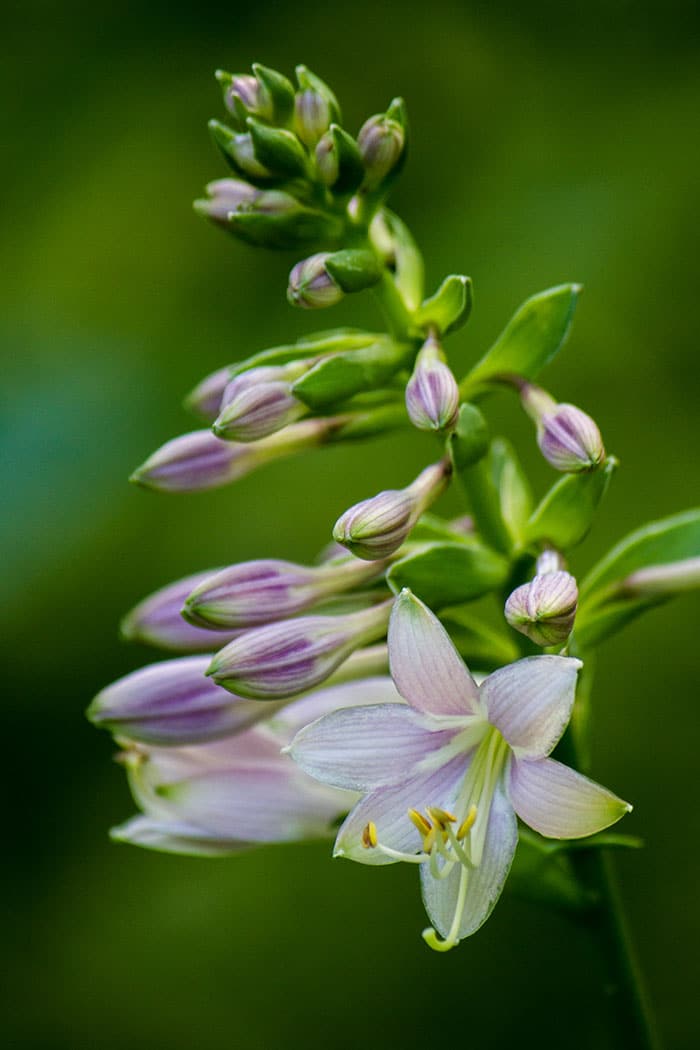
The first hosta flower spikes are appearing all over the garden. I like their architectural structure, rising on stems high above the plants and swaying in the breeze. Upright-growing ‘Krossa Regal’ (Zone 4) has pale lavender flowers carried on four- to five-foot tall stems, making a unique display. All hosta flowers are attractive in their simplicity, looking like little flared trumpets or miniature Easter lilies. Perhaps one of the most striking is Hosta plantaginea, which has large, scented white trumpets in August. The species has a lovely hybrid sister, H. p. ‘Aphrodite’, with double scented flowers. Both like full sun.
Hosta flowers must be generous produces of nectar, because I see bees repeatedly visiting the blooms. All this attention from bees results in fertilization and seed production, mostly in the species plants. (Hybridized hostas have flowers, but not all will produce seeds.) I have a large specimen of Hosta sieboldiana ‘Elegans’ that produces a great number of seeds each autumn, contained in elongated pods that crack open when the nights become frosty. The seeds are eagerly harvested by cardinals and juncos, and the birds will continue to hunt for spilled seeds into winter, so long as snow doesn’t cover the area.
One October a few years ago, I took some of the seeds and planted about 200 of them indoors. I surface-sowed them on moist vermiculite, put the container in a plastic bag, and set it on top of the kitchen cabinets where warm air accumulates. And I forgot about them. About eight weeks later, someone noticed small green leaves up near the ceiling, and the container was retrieved. Every one of those hosta seeds germinated and grew!
I pricked them out and put them into plastic cell packs, then put the little hostas under plant lights. It was certainly a long and busy winter caring for the little seedlings, and I gave away as many as possible to friends the following spring and summer. Today I have lots of these homegrown hostas blooming in the garden, many showing the blue-green colour and ribbed, waffled leaf characteristics of their H. sieboldiana ‘Elegans’ mother. This was a cost-effective way to acquire many hosta plants, and become caregiver to a small army of jolly green seedlings. This isn’t something I would do often—in fact, once was enough!









Hi Ann,
So glad to know I’m not the only gardener to try this! I had a few that clearly resemble the parent, H. sieboldiana ‘Elegans’ — but not exact replicas. Then there are some that have only one characteristic from the parent, such as a dimpled, veined or waffled foliage, but dull green colour. Or others, with the blue-green colour, but little detail in the leaves. But none of them was an exact replica of the mother, although they probably were good representations of ancestors.
I once made a similar experiment, collecting seed from hybrid impatiens plants and growing them the following season.Then I collected seed from that generation, and grew them out again. As I worked backward over four years, the plants produced increasing percentages of pink flowers. Probably the species ancestors were that pink colour.
So what’s our next experiment?
— Judith
Tried the same with Frances Williams…had 5 survive and after years of patient waiting have very plain green offspring. (Thought I might create the next soughtafter Hosta…ha ha!)